Vaccine Injury Photos From The CDC
These pictures are from the Centers For Disease Control in America, entitled ‘Vaccine Reaction Images’ and can be found at:
http://www.bt.cdc.gov/Agent/Smallpox/VaccineImages.asp
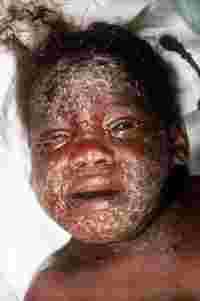
This little girl is suffering from Eczema Vaccinatum, which is a severe eczema caused by vaccination.
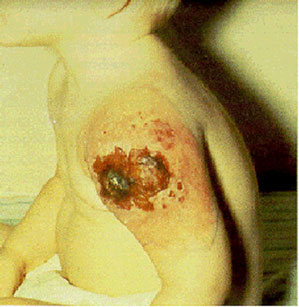
This boy had progressive vaccinia, a massive flesh eating infection caused by vaccination. He had been immuno compromised prior to his shot and unfortunately he died as a result of his injuries.
Source: [from Fenner F., Henderson DA, et al. Smallpox and its Eradication. WHO. 1988]
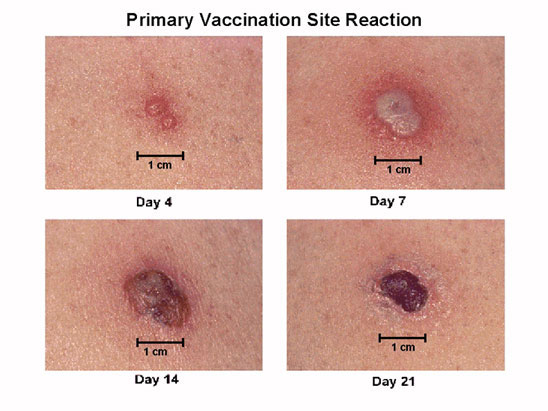
Vaccine site reaction after a period of time.
Eczema Vaccinatum Lesions (Smallpox) On A Smallpox Vaccinated Person – Photo From American Academy Of Pediatrics
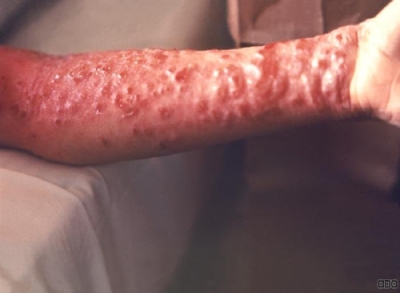
See:
http://aapredbook.aappublications.org/week/iotw030308.shtml
Reaction From Smallpox Vaccine, Photos Taken March and April 2009

Source:
May 19, 2009 / 58(Early Release);1-4, CDC.
WHO VACCINE DEATH REPORTS
Some were vaccine deaths, others were injected with other drugs by accident
In 1997 in country A, four separate AEFI clusters of “collapse” occurred up to five minutes following immunization with measles vaccine. All 14 cases presented with hypotonia; 11 became pale; seven cases had cyanosis, dyspnoea and increased saliva secretion; three patients had depressed respiration and one patient died; others recovered in less than one hour. In two of the clinics vials that contained muscle relaxants were found stored with vials containing diluent, and of the same size and shape;labels on a number of vials recovered could not be read. Infrared spectrophotometry of the urine of one of the cases and thin layer chromatographic analysis of vaccine from one of the implicated vials
showed the presence of muscle relaxant.B Cause: Use of muscle relaxant instead of diluent.
In one hospital in 1992 in country B, five neonates collapsed a few minutes following immunization with BCG and OPV. Four were resuscitated and one died. Muscle relaxant drugs were found in the refrigerator in which vaccines were also kept.
B Cause: Use of muscle relaxant instead of diluent.
In 1997 in country C, 21 infants died out of 70 infants supposedly given DTP vaccine. Insulin was
stored in similar vials and in the same refrigerator as DTP vaccine.
B Cause: Use of insulin instead of DTP.
Three infants died, in 1995 in country D, after administration of measles vaccine. Symptoms,
developing within five hours post immunization, were fever, rash, vomiting, and diarrhoea, described by the attending health worker as “toxic shock syndrome.” Reconstituted vaccine was routinely kept until it was used, and syringes were never sterilized, but washed with ordinary water and wiped with cotton wool. No testing could be done.
B Cause: Non-sterile injection (contaminated reconstituted vaccine).
In 1996 in country E, four children died and a fifth was hospitalized after receiving measles vaccine from the same vial. Vaccine was not refrigerated, and was transported house to house for immunization. Reactions began four to five hours after vaccination, with vomiting, unconsciousness,and meningeal irritation. S. aureus was cultivated from the incriminated vial.
B Cause: Non-sterile injection (contaminated reconstituted vaccine).
Source: http://www.who.int/immunization_safety/publications/aefi/en/AEFI_WPRO.pdf
A 6-year-old boy with edematous, erythematous papules on arms, legs
A 6-year-old boy presents to your office with worsening rash. He began developing small skin-colored to pink papules on the right chest approximately 7 months ago. The papules spread to his right arm and abdomen. They are asymptomatic. Approximately 3 weeks ago, his parents noticed he erupted in larger, pruritic papules appearing on the extensor arms and legs. He is otherwise well. His sister had similar, small, skin-colored papules on the arms for several months that resolved last year without treatment.
Molluscum contagiosum (MC) is a type of poxvirus that causes a common cutaneous viral infection. It typically presents with small, umbilicated, translucent, pink papules in children with a predilection for the skin folds. The rash is self-limited, although in some patients it takes months or, rarely, years to resolve and may be symptomatic or cosmetically displeasing. Thus, some parents and children desire treatment. Patients can develop inflammatory reactions to the virus de novo or after therapy for molluscum. These reactions include eczematous dermatitis, inflamed, suppurative molluscum lesions, and Gianotti-Crosti syndrome-like reaction (GCLR).
Gianotti-Crosti syndrome (GCS) also is known as papular acrodermatitis of childhood. Gianotti described the rash first in 1955, and then reported more cases with Crosti in 1956. It typically develops after a viral infection and has been reported to follow vaccinations, as well. Hepatitis B and Epstein-Barr virus infections are the most often cited viral triggers, but several other viruses have been associated with the exanthem. It classically presents with papules on the cheeks, arms, legs and/or buttocks with notable sparing of the trunk in most cases. The papules are symmetric and primarily on extensor surfaces. The mechanism causing this exanthem is unknown.
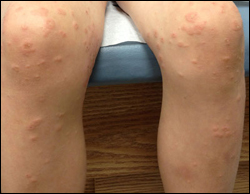
Source: Infectious Diseases in Children, February 2014.
